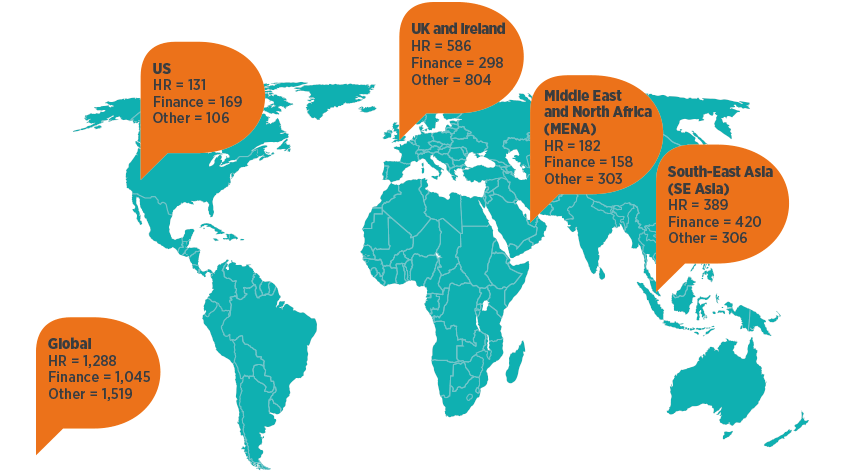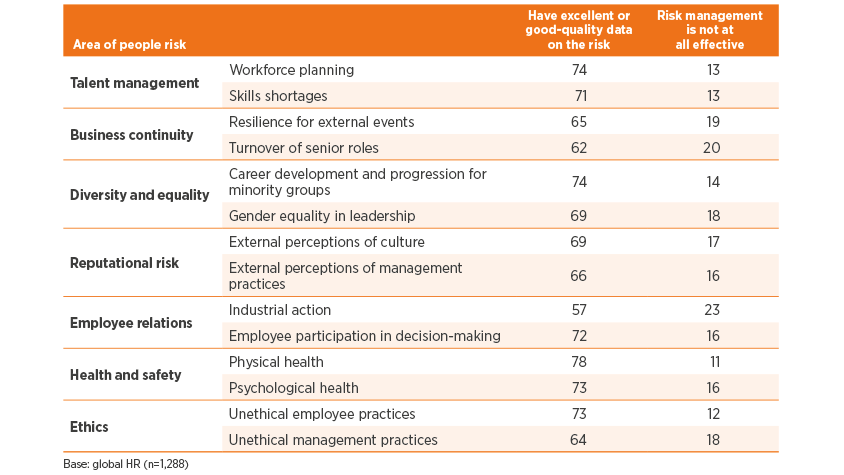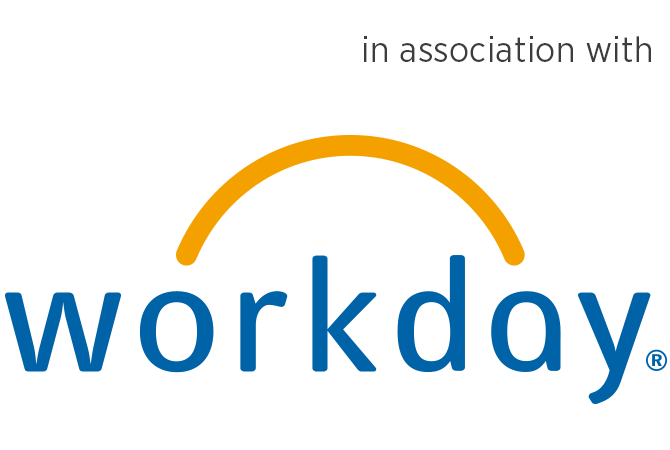Introduction
People analytics is rising up the agenda for organisations globally. With technology providing businesses more and more ways to collect people data, using this information to gain workforce insight, drive business performance and enhance employee experience is expected to grow.
To gain international perspectives on how organisations use people analytics, our recent survey People analytics: Driving business performance with people data asked 3,852 business professionals from the UK and Ireland, US, Middle East and North Africa (MENA) and South-East Asia their views on how their organisations use people analytics to understand people data (see Figure 1). This global survey finds that HR professionals using people data to tackle significant challenges, with three-quarters (75%) tackling workforce performance and productivity issues using people data. But, the survey also reveals that how and when organisations use people data differs across region. These international focus reports examine how business professionals in the UK and Ireland, MENA, US and SE Asia use people data and compares regional practice.
Figure 1: Participants in our research

Purpose of the study
We used the findings from the survey to understand:
- How people analytics is influencing organisation-level outcomes such as performance and culture.
- How different professional groups, such as HR and finance, view the impact of people analytics.
- How capable the HR function is with people analytics and people data.
- How people analytics is being used to understand the business challenges and people risks that organisations are facing.
Download the reports below
Executive summary: People analytics: driving business performance with people data
Download the executive summaryInfographic: People analytics: driving business performance with people data
Download the infographicKey findings
Strong people analytics culture leads to good business outcomes
Using the survey we were able to describe a strong people analytics culture as existing in organisations that:
- actively use people data to tackle business problems
- have management teams that frequently speak about the value and importance of people data, transparency and insights
- have line managers who seek out people data to make business decisions.
We then surveyed non-HR professionals on the impact of people analytics in their business. We found that people analytics culture is positively associated with overall business performance: 65% of those who said they work in an organisation with a strong people analytics culture said that their business performance was strong when compared with competitors, but only 32% of those in weak analytics cultures report strong business performance. This represents a 33-point difference.
Figure 2: Strong business performance compared with strong culture (%)
[Base: global non-HR (n=667)]
We also found that HR professionals are using people data to tackle significant challenges their organisations are facing. Our survey found that 75% of HR professionals globally are tackling workforce performance and productivity issues using people data, illustrating the importance of this information for strategic workforce issues.
Figure 3: Use of people data to tackle key business challenges (%)
[Base: global HR (n=1,288)]
Access to people data for decision-making
We found that visibility of data (for example via data dashboards), correlates with improved outcomes, but access differs by profession: while almost three-quarters (71%) of HR professionals globally have access to people data, only two-fifths (42%) of finance professionals state that they do, illustrating a clear gap between the professions.
Figure 4: Do you have access to workforce/people data that is produced by your organisation? (%)
[Base: global HR (n=1,288); global finance (n=1,045); global other (n=1,519)]
We found that visibility of people data improves perspectives on performance, with 73% of respondents from a strong performance business agreeing or strongly agreeing that they have access to a dashboard of people data, in comparison with 50% of those who indicated their business is of average performance.
Figure 5: Management has access to a people data dashboard (%)
People data skills and confidence
Overall we found that the HR profession continues to lack the skills and confidence to undertake advanced levels of people analytics. We found that this differed by region, for example HR professionals in the UK lack the confidence to conduct advanced people analytics: just over one-fifth (21%) of UK HR professionals are confident conducting advanced analytics, compared with 46% in SE Asia, representing a 25-point difference.
Figure 6: Confidence conducting analytics (%)
[Base: Global HR basic analytics (n=1,160); UK HR basic analytics (n=524); SE Asia HR basic analytics (n=357); MENA HR basic analytics (n=167); US HR basic analytics (n=112); Global HR intermediate analytics (n=1,045); UK HR intermediate analytics (n=446); SE Asia HR intermediate analytics (n=343); MENA HR intermediate analytics (n=158); US HR intermediate analytics (n=98); Global HR basic multivariate techniques (n=856); UK HR basic multivariate techniques (n=315); SE Asia HR basic multivariate techniques (n=314); MENA HR basic multivariate techniques (n=147); US HR basic multivariate techniques (n=80); Global HR advanced multivariate techniques (n=735); UK HR advanced multivariate techniques (n=229); SE Asia HR advanced multivariate techniques (n=294); MENA HR advanced multivariate techniques (n=140); US HR advanced multivariate techniques (n=72)]
In our analysis of UK data we found there is untapped potential in UK HR professionals: we found that 21% of UK HR professionals say they are confident or very confident with the more advanced techniques, such as structural equation modelling, but only 6% of UK HR professionals say they use these in their day-to-day role, suggesting many HR professionals do not have the opportunity to use their skills in their role. We also investigated other professional perspectives on HR skills and capability.
Figure 7: Professional perspectives on HR people data skills (%)
[Base: global HR (n=1,288); global finance (n=1,045); global other (n=1,519)]
People risk, data protection and data security
Data protection of workforce data continues to be an important issue for all professional groups: there is broad agreement across all professional groups that overall people data is adequately protected. Less than two-thirds (61%) of HR professionals believe their organisation has a joined-up approach to protecting its data.
Figure 8: Professional perspectives on data protection (%)
[Base: global HR (n=1,288); global finance (n=1,045); global other (n=1,519)]
We also investigated the quality of people data available for understanding key people-related risks. We found that data quality is often highly rated, but risk management of some key people risk areas, such as turnover of senior roles, have low levels of effectiveness.
We also investigated the quality of people data available for understanding key people-related risks. We found that data quality is often highly rated, but risk management of some key people risk areas, such as turnover of senior roles, have low levels of effectiveness.
Table 1: Effectiveness of risk management types and correlation with analytics culture (%)

Conclusions and recommendations
We found that the transparency of workforce data is critical if it is to be used by line managers in their decision-making, in particular those in finance-related roles. Visibility of people data helps HR and non-HR in making decisions.
Another important finding from this study is the importance of people analytics skills and confidence to driving good outcomes. Regional variation shows how skills and confidence are related to outcomes, with SE Asia often leading practice with higher-quality analytics skills. The UK is particularly limited in both confidence and skills levels, highlighting a potential risk to future capability.
We also found that people risk, which is an emerging area in practice, is being understood through the application of people data. Issues such as people data security have become important given the recent implementation of the General Data Protection Regulations in the EU and are being measured using people data. However, there is still some way to go to improve how HR professionals articulate broader issues of people risk and opportunity.
This work highlights that there is much potential in developing people analytics practice, both in terms of the HR teams producing and consuming data, and the non- HR professionals still to realise the potential value of people data to their outcomes. HR must take the lead to establish people analytics as a core component of the future evidence-based profession. Only by doing this do we believe that the potential value long promised by people analytics will finally be realised.
Key recommendations for HR practice
We make the following key recommendations for HR practice:
- Integrate people analytics and new perspectives on people risk and opportunity: the risk and opportunity perspective offers a unique way to understand value creation and value capture by organisations. Using people data can help to uncover how this works in practice.
- Build stronger cross-functional relationships to improve the impact of people analytics: non-HR functions require encouragement to increase the use of people data in their practice and for long-term decision-making. HR leaders and business partners should use this opportunity to build relationships using people data, and focus on delivering business value.
- Build people analytics skills and confidence in the profession: an important story to emerge from this study is the impact of low skills and low confidence on the quality of outcomes from people analytics. HR leaders must invest in and develop the skills and confidence of HR professionals, and ensure they have the opportunities to undertake people analytics projects.
CIPD Trust
Tackling barriers to work today whilst creating inclusive workplaces of tomorrow.
Bullying
and harassment
Discover our practice guidance and recommendations to tackle bullying and harassment in the workplace.

Explore the CIPD’s point of view on people analytics, including recommendations for employers

An exploration of how generative AI tools like ChatGPT can be used effectively to support human resource management

Understand what people analytics is, different types of HR data, and the importance of people analytics strategy and process

Learn about defining, measuring and reporting human capital, and how HR can use human capital information to drive performance
Explore our related content

Insight from the CIPD’s survey into factors driving pay decisions in UK workplaces and recommendations for practice

Find out about the importance of neuroinclusive workplaces, what employers are doing and the working experiences of neurodivergent and neurotypical employees

A report seeking common ground in skills policy across the UK’s four nations

Insight into how global issues are impacting people professionals in the UK, Ireland, Asia-Pacific, MENA and Canada

